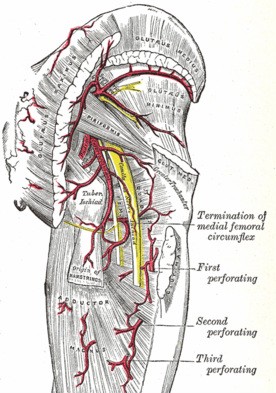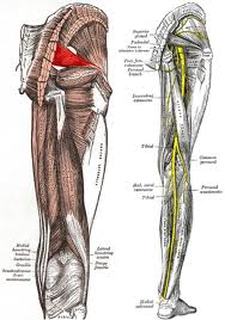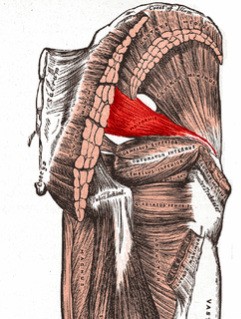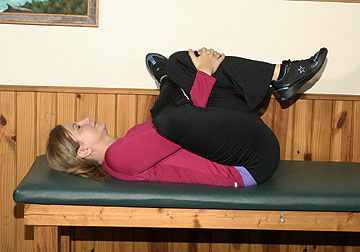Piriformis Syndrome
The Piriformis Muscle (piriformis; ‘pear shaped‘) is a tiny muscle located deep in the buttocks underneath the much larger Gluteal Muscles. This little muscle is the most well-known of a group of several muscles known as the ‘Hip Rotator Cuff ‘ and is frequently the source of one’s PAIN IN THE BUTT.
Piriformis Syndrome is a miserable condition in which the Piriformis Muscle becomes overly tight and either compresses the Sciatic Nerve, pulls at its bony attachment points (Piriformis Tendinosis), or both. Although there are frequently underlying biomechanical / physical issues that contribute to Piriformis Syndrome (bow legs or knock knees, high or low arches, leg length discrepancy, pelvic deficiency, past trauma, obesity, sedentary lifestyle / over-training, poor posture, too much time on concrete, years of cruddy footwear, etc, etc,), pathological tightness of the Piriformis Muscle is frequently the result of FASCIAL ADHESIONS and / or TENDINOSIS.
Piriformis Syndrome can be aggravated by bending, lifting, sports, working out, running, and even driving (foot on the gas pedal), but sitting tends to be the worst aggravating factor for most people. A serious inability to sit without severe buttock pain and / or Sciatica is a big red flag as far as Piriformis Syndrome is concerned. Contrary to what your M.D. might tell you, there are no drugs that effectively treat Piriformis Syndrome, and surgery is iffy at best, although there are some specialists who are getting a handle on fixing some of these surgically.
THREE PLUS DECADES OF PIRIFORMIS SYNDROME
THE PIRIFORMIS MUSCLE AND BUTTOCK PAIN
Piriformis Syndrome is an extremely common condition, and is far more likely to be found in women than men (some studies claim 12-15 times more often). Although I can only speculate on the reason for this, I suspect that it is largely a child-bearing issue. Some of it probably also has to do with the naturally wider shape of a woman’s pelvis, which is the most likely explanation for my finding it much more frequently in women than men, even if they have not had children.
As I stated earlier, Piriformis Syndrome is a major cause of sciatica (leg pain, numbness, tingling, or weakness, in any combination), hip pain, and / or buttock pain. Because sciatica is so often involved, it is often misdiagnosed as a slipped disc, herniated disc, or a chronic low back or sacroilliac problem. A 2005 study by UCLA’s Mount Sinai Medical School revealed that of 240 randomly picked individuals with Sciatica; the number one cause was Piriformis Syndrome. This is quite revealing considering that although I have seen many patients who have come from out of state to see me specifically for “Piriformis Syndrome”, I have yet to treat a local patient who has ever heard the term used before. In other words, I feel that UCLA is at least in the ball park with this study —— Piriformis Syndrome is being incredibly under-diagnosed / misdiagnosed.
The Sciatic Nerve is both the largest and longest nerve in the body, and at its largest point is about the thickness of one’s thumb. It originates in the low back (lumbar spine region) and angles toward the middle of the buttock. It then extends down through the leg after passing underneath the Piriformis Muscle. Be aware that in as much as half the population, the sciatic nerve travels through the Piriformis Muscle, passes over the Piriformis Muscle, or splits in two and passes directly around the Piriformis Muscle (pictures at bottom of page).
If you were anything like me, as a kid you were probably intrigued by stories about the Bermuda Triangle. This area, off the southeast coast of the United States, is also known as the Devil’s Triangle. It happens to be an area where hundreds (if not thousands) of aircraft and boats have mysteriously vanished without a trace. Piriformis Syndrome is often just as mysterious, often sucking sufferers into its debilitating grasp, while leaving doctors (sometimes self included) scratching their heads and searching for answers.
PIRIFORMIS SYNDROME VIDEO TESTIMONIAL PAGE
| RIGHT PIRIFORMIS MUSCLE |
 |
| The right side Piriformis Muscle is seen in red. Notice the small hole / notch just underneath the muscle. This is where the Sciatic Nerve comes through. |
| RIGHT PIRIFORMIS MUSCLE / SCIATIC NERVE |
 |
| This is the same picture, except you can see the Sciatic Nerve and the artery that travels with it. Any sort of spasm or abnormal tension on the Piriformis Muscle can cause pressure on the Sciatic Nerve. The result is Piriformis Syndrome — a deep ache in the buttock that is often accompanied by pain, numbness, tingling, paresthesia (odd sensations), or weakness in the leg. |
THE DEVIL’S TRIANGLE OF PIRIFORMIS PAIN
 |
| Note the “Devil’s Triangle” in relationship to the butt crack (pardon my lingo). If you have a constant pain in this triangle, odds are you have Piriformis Syndrome. Be warned. Piriformis Syndrome is frequently mistaken for a disc-based sciatica. And although their symptoms can be extremely similar, they are two very different problems that have to be treated very differently from each other. |
PIRIFORMIS SYNDROME PICTURES
| SCIATIC NERVE AND PIRIFORMIS MUSCLE |
 |
| PIRIFORMIS MUSCLE |
 |
| SCIATIC NERVE |
 |
The Sciatic Nerve is both the biggest and longest nerve in the body. When this nerve is irritated, pinched, or compressed in any fashion, you will typically get a deep buttock pain and numbness, tingling, weakness, or paresthesias (odd sensations) down the leg (HERE). After a decade of dealing extensively with Piriformis Syndrome patients, one of the most shocking discoveries I have made is just how few sufferers have ever heard the term used. If you look at my PIRIFORMIS SYNDROME VIDEO TESTIMONIAL PAGE, you will see four people (Ike Reese, Cathy Lee, Deb Aldridge, and Gail Hawkins) who between them, suffered with almost a century and a half of Piriformis Syndrome. Not a single one of them had ever heard the word used before! Would it have made any difference if they had? Doubtful. God bless them, but most doctors are locked into the same old things that do not help you get better —- MRI’s, pain pills, muscle relaxers, anti-inflammations drugs, shots, and eventually disc surgery.
MORE PIRIFORMIS SYNDROME
The symptoms of Piriformis Syndrome usually begin as a deep aching in what women like to refer to as their ‘hip’ area. This pain will be found along an imaginary line that runs from the very tip top of the butt crack, to the Greater Trochanter of the femur (the bony knob on the upper portion of the outer or lateral thigh / hip). Due to mechanical stresses causing chronic tightness or outright muscle spasm, the Piriformis Muscle can actually become shortened over time. This itself can often result in microscopic scarring of the fascial sheaths that tightly surround the muscle, which in turn causes both local pain (pain in the butt) and compression of the Sciatic Nerve (leg pain).
For years, I did not really understand why I had such good clinical results with so many cases of buttock / hip pain and sciatica, while other seemingly identical cases were largely unresponsive to chiropractic adjustments — no matter how many were given. Frequently these “problem” cases would get fantastic short-term results from their adjustment, but the results never seemed to last more than a few days at the most (and often no more than a few hours). It was not until I got involved with SCAR TISSUE REMODELING in early 2001, that I began to understand the process.
Over the past decade I have come to realize that Piriformis Syndrome is literally “epidemic” in the female portion of our society. It is and always has been our number one webpage by far (see our PATIENT TREATMENT DIARY Blog Post), with the medical community being largely mystified about what it really is, what causes it, or how to treat it effectively — or even how to diagnose it.
As you have read on our blog post, TWENTY REASONS WHY FASCIA…., you already know that Scar Tissue is normal tissue (think nicely combed hair here) that has been disrupted from its organized structure, into a balled-up and tangled wad of inflexible and hyper-sensitive, micro-gristle (think of a hair tangle that cannot be combed out) — a HAIRBALL if you will. This kind of microscopic scar tissue is not typically in the muscle itself, but in the fascia. Fasciae are the cellophane-thin, but very tough, yellowish white membranes that cover muscles. In my neck of the Ozarks, deer hunters call these membranes, ‘Striffin‘. Today I fixed a case of chronic Piriformis Syndrome in a young deer hunter who, once he understood that Striffin is really Fascia and was what was causing his pain, described to me how tough Fascia really is. He told me that Fascia is the stuff that’s, “hell on meat grinders“.
Fascia is arguably the single most pain-sensitive tissue in the body! Fascial Adhesions cause pain and dysfunction, yet will not show up with even the most technologically advanced imagining techniques such as MRI. Destroy Fascial Adhesions and you are often on your way to destroying Chronic Pain! -Dr. Russell Schierling, Schierling Chiropractic, LLC
MORE PICTURES OF PIRIFORMIS SYNDROME & THE SCIATIC NERVE
| PIRIFORMIS MUSCLE / SCIATIC NERVE | PIRIFORMIS MUSCLE / SCIATIC NERVE | PIRIFORMIS MUSCLE / SCIATIC NERVE |
|---|---|---|
 |  |  |
| Image by Anatomist90 | Photo by Anatomist 90 | Photo by Anatomist 90 |
PIRIFORMIS TENDINITIS / PIRIFORMIS TENDINOSIS
Hopefully, you have already spent some time on our TENDINITIS -vs- TENDINOSIS page. Be aware that it is very possible (even fairly common) to have a Piriformis Tendinosis (most doctors that actually diagnose this condition will refer to it as Piriformis Tendinitis). This means that the tendon is becoming microscopically frayed and deranged due to chronic mechanical stress — or God forbid, CERTAIN KINDS OF ANTIBIOTICS. Piriformis Tendinosis is a common component of many cases of Piriformis Syndrome. In fact, sometimes it is hard to tell whether a person’s Piriformis Syndrome is due to Fascial Adhesions or Tendinosis. The great thing is that I treat both problems in a very similar manner since they are very similar problems in very similar tissues.
FOOT PROBLEMS & PIRIFORMIS SYNDROME
If you have extra-high arches or extremely flat feet, or if you have abnormal lower body biomechanics of any sort; you probably need arch supports (orthotics). We carry some nice, generic orthotics that will work for many of you. However, some of you will require custom orthotics. Allow me to tell you why high arches can be a big contributor to Piriformis Syndrome using a personal example.
People with flat feet tend to be “knock-kneed” because the more the arch collapeses, the more it drives your knees twoard each other. Likewise, the higher the arch, the more you get ‘pushed’ onto the outsides of your feet. To see what this does to the Piriformis Muscle, stand up and put your hands on your upper buttocks in the area of the Piriformis Muscle. Now, roll your weight out onto the outsides of your feet (bow your legs out ‘cowboy style’). Notice how the Piriformis Muscle instantly becomes tight as a drum. This is what is going on all day long if you have improperly supported high arches. From personal experience, I can tell you that there is only one company on the planet that specifically specializes in shoe inserts (orthotics) for people with high arches……. XF
The only custom orthotic company that I recommend for my patients is XTREME FOOTWERKS of Idaho Springs, CO. Because of old basketball injuries (several broken ankles), I have had both Piriformis Syndrome and a non-PLANTAR FASCIITIS sort of chronic arch pain. I also happen to have arches that are ridiculously high (cavus). Because I am constantly solicited by companies that sell orthotics, I’ve had the opportunity to try at least 30 pairs of orthotics made by other companies. Then, by an act of God, I met Shawn. Shawn Eno is a biomechanical genius! He and his company, Xtreme Footwerks, build custom orthotics for all foot types, but, is the only lab I am aware of that actually specializes in orthotic devices for high arches. It would not be a stretch to say that Shawn helped save my life and career.
BLOG ARTICLES / TESTIMONIALS PIRIFORMIS SYNDROME
STRETCHES FOR THE PIRIFORMIS
| STANDING PIRIFORMIS STRETCH |
 |
| SEATED PIRIFORMIS STRETCH |
 |
| LYING PIRIFORMIS STRETCH |
 |
Be sure to visit our STRETCHING PAGE as well. This is not a page to show people what I like to refer to as ‘Wellness Stretches”. Although I think regular stretching is a good thing, that is not what this site is all about. Our various Stretching Pages (including a page on PIRIFORMIS STRETCHES) are dedicated to demonstrating stretches specifically for people suffering with various CHRONIC PAIN SYNDROMES — particularly those who have been through our TISSUE REMODELING TREATMENT. One more thing. Make absolutely sure you do not OVERSTRETCH THE PIRIFORMIS MUSCLE as you can aggravate it for days — or even weeks.

2 Responses
I live in New Jersey. Is there a doctor closer to me that practices scar tissue remodeling therapy? Thank you.
I believe that I tore my pirformis muscle, when I had an accident in a friends house, not realizing there was a step down, and almost falling, I felt a heard a sharp snap in my right butox , which caused me to have instant terrible pain. I’ve not been able to get relief. Is it okay to stretch when I believe its torn?